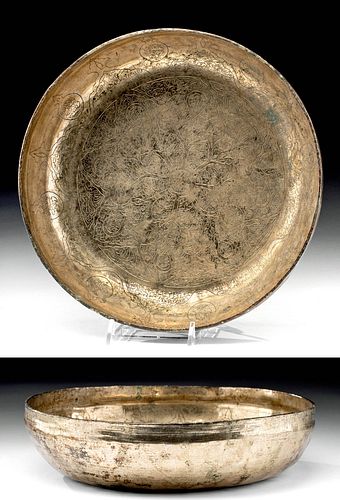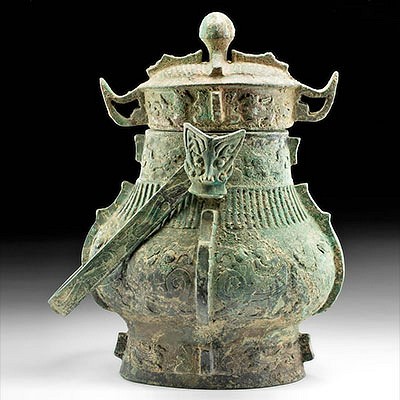Timurid Bronze Bowl
Lot 71
About Seller
Artemis Fine Arts
686 S Taylor Ave, Ste 106
Louisville, CO 80027
United States
Selling antiquities, ancient and ethnographic art online since 1993, Artemis Gallery specializes in Classical Antiquities (Egyptian, Greek, Roman, Near Eastern), Asian, Pre-Columbian, African / Tribal / Oceanographic art. Our extensive inventory includes pottery, stone, metal, wood, glass and textil...Read more
Categories
Estimate:
$1,400 - $2,000
Absentee vs Live bid
Two ways to bid:
- Leave a max absentee bid and the platform will bid on your behalf up to your maximum bid during the live auction.
- Bid live during the auction and your bids will be submitted real-time to the auctioneer.
Bid Increments
| Price | Bid Increment |
|---|---|
| $0 | $25 |
| $300 | $50 |
| $1,000 | $100 |
| $2,000 | $250 |
| $5,000 | $500 |
| $10,000 | $1,000 |
| $20,000 | $2,500 |
| $50,000 | $5,000 |
| $100,000 | $10,000 |
| $200,000 | $20,000 |
About Auction
By Artemis Fine Arts
Jul 1, 2020
Set Reminder
2020-07-01 10:00:00
2020-07-01 10:00:00
America/New_York
Bidsquare
Bidsquare : Ancient | Near-Eastern | Asian Art
https://www.bidsquare.com/auctions/artemis-gallery/ancient-near-eastern-asian-art-5276
Ancient art from Egypt, Greece, Italy and the Near East, as well as Asian, Fossils, Pre-Columbian, Native American, African / Tribal / Oceanic, Spanish Colonial, Russian Icons, Fine art, much more! Artemis Fine Arts info@artemisgallery.com
Ancient art from Egypt, Greece, Italy and the Near East, as well as Asian, Fossils, Pre-Columbian, Native American, African / Tribal / Oceanic, Spanish Colonial, Russian Icons, Fine art, much more! Artemis Fine Arts info@artemisgallery.com
- Lot Description
Western Asia, Samarkand region (sometimes Samarqand, Transoxiana), ca. 15th century CE. A shallow bronze basin with a slightly emphasized rim and ornately incised interior. It features a motif that resembles a flower or perhaps the ceiling of an Islamic palace or mosque, its interior filled with dense written characters. The exterior is undecorated, the bronze allowed to sparkle brilliantly. Size: 9.75" W x 2.4" H (24.8 cm x 6.1 cm)
Timur (Tamerlane) founded the Timurid Dynasty around 1370 CE, making his capital in Samarkand. He quickly conquered vast swaths of Central Asia, Iran, Iraq, southern Russia, and even parts of the Indian subcontinent. This vast empire defeated the Mamluks and the Ottomans, but Timur died before his plans to invade China came to fruition. Aside from his brutal conquests, Timur created a legacy of outstanding Islamic artwork by bringing artists from all over his empire to Samarkand. The later Timurid capital of Herat continued the tradition and the pottery and metalwork made there was traded along the Silk Road and highly valued beyond the boundaries of the empire.
Provenance: private California, USA collection, by descent, moved from Germany in 1997, originally collected in the 1970s in Hamburg, Germany
All items legal to buy/sell under U.S. Statute covering cultural patrimony Code 2600, CHAPTER 14, and are guaranteed to be as described or your money back.
A Certificate of Authenticity will accompany all winning bids.
We ship worldwide and handle all shipping in-house for your convenience.
#156067Patina has largely been cleaned. Beautiful preservation of motifs with light deposits on surface. Form is very slightly bent.Condition
- Shipping Info
-
All shipping is handled in-house for your convenience. Your invoice from Artemis Gallery will include shipping calculation instructions. If in doubt, please inquire BEFORE bidding for estimated shipping costs for individual items.
-
- Buyer's Premium



 EUR
EUR CAD
CAD AUD
AUD GBP
GBP MXN
MXN HKD
HKD CNY
CNY MYR
MYR SEK
SEK SGD
SGD CHF
CHF THB
THB



















